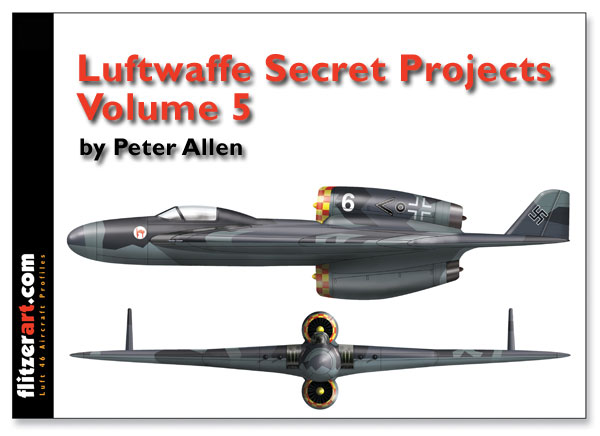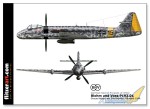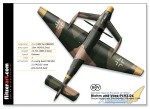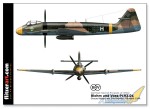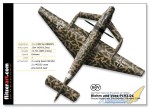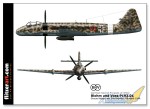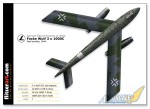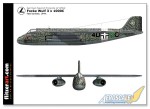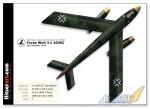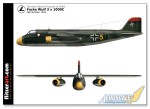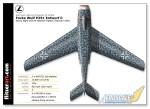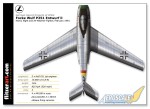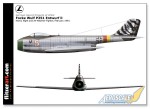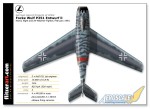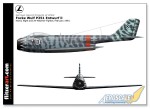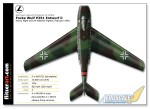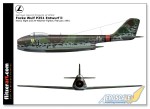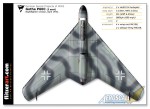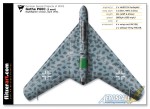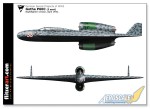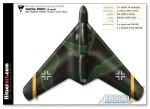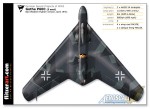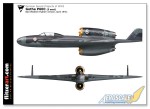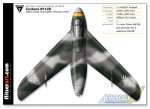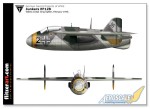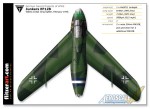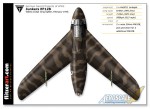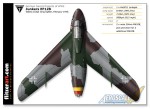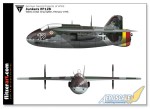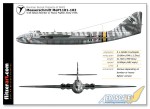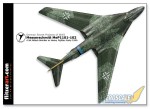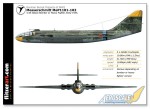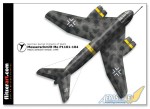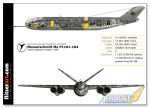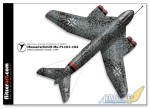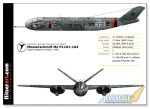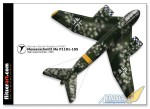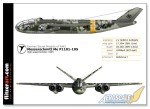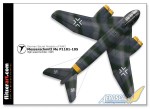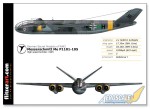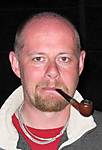German Secret Projects of WW2 Volume 5.
4
Comments
Hi again.
Another set of new and re-worked profiles
The design was symmetrical in layout but featured the fuselage being made in two separate parts. The cockpit and the nose armament were housed in the forward fuselage which was supported by two booms projecting from the main wing’s leading edge and the smaller forward wings. The main fuselage housed the Daimler Benz DB 603G engine, driving a propeller that was immediately behind the cockpit. The propeller blades were attached to a large circular boss that followed the shape of the fuselage.
The version shown here is the first one with a straight edged tail plane, the second version saw a distinct taper to this.
The RLM rejected the design on grounds of insufficient data concerning the novel layout.
The design housed its two engines under the cockpit at the forward fuselage, both sharing a common air intake.
More versions in a later set.
The cockpit was pressurised and provided with an ejector seat and armour. The design showed much promise having had good wind tunnel results with a scale model.
The design also saw a night fighter/all-weather fighter version incorporating a lengthened fuselage with room for a two man cockpit. Unfortunately neither project was completed due to the end of the war.
The P.60C nightfighter and all-weather fighter was the final design in the series. Its not clear which engines were to be used, two HeS 011 or two BMW 003 turbojets. A fuselage was added, to accommodate the installation of a radar set and its antenna, plus the crew of two sat in tandem rather than lying prone.
Another version was to accommodate a crew of three in a novel way. The pilot sat in a single seat cockpit in the normal way with 2 compartments in the wing roots to house the other crew members.
In addition it was intended to also develop a version for the heavy fighter role.
The designs introduced a new wing configuration; the ‘sickle’ which was also seen on a version of the Arado Ar234.
The heavy fighter version was to incorporate a heavy cannon mounted on the starboard side of the nose.
That’s it for this time. More coming.
The following references proved invaluable in helping me to produce these profiles.
Dan Johnsonís Luft 46 site: www.luft46.com
Luftwaffe Secret Projects: Fighters 1939-1945 by Walter Schick and Ingolf Meyer,
Luftwaffe Secret Projects: Strategic Bombers 1935-1945 by Dieter Herwig and Heinz Rode.
Luftwaffe Secret Projects, Volume 3: Ground Attack & Special Purpose Aircraft by Dieter Herwig and Heinz Rode.
Jet Planes of the Third Reich Vols 1 and 2 by Manfred Griel
Plus special thanks to members of www.secretprojects.co.uk for advice and data and our very own Rowan (Merlin).
Another set of new and re-worked profiles
Blohm and Voss Bv P192
The Bv P192 was one of numerous designs by Blohm and Voss for a ground attack and dive bomber to replace the aging Ju 87. All these designs attempted to move the engine and prop behind the forward fuselage leaving the nose free for housing the pilot and main armament offering the advantage of concentrated firepower and a superior view from the cockpit.The design was symmetrical in layout but featured the fuselage being made in two separate parts. The cockpit and the nose armament were housed in the forward fuselage which was supported by two booms projecting from the main wing’s leading edge and the smaller forward wings. The main fuselage housed the Daimler Benz DB 603G engine, driving a propeller that was immediately behind the cockpit. The propeller blades were attached to a large circular boss that followed the shape of the fuselage.
The version shown here is the first one with a straight edged tail plane, the second version saw a distinct taper to this.
The RLM rejected the design on grounds of insufficient data concerning the novel layout.
Focke-Wulf Fw 3x 1000C
The third design in a set of three, the 1000x3 C was similar to the first design A, but the slim fuselage was much deeper. The design featured parallel wings and tailplane with the HeS 011engines mounted on underwing pylons. The engines were turned outwards to assist in improving single engine controllability.Focke-Wulf Fw P251 Entwurf ll
In February 1945 Focke Wulf produced the second night fighter design in a known series of five, the Entwurf ll.The design housed its two engines under the cockpit at the forward fuselage, both sharing a common air intake.
More versions in a later set.
Junkers Ju P128
Junkers submitted this design for the Emergency Fighter Competition in February 1945. The fighter was of a very advanced design with 45 degree swept back wings of wooden construction with a pair of small vertical fins and rudders mounted on the trailing edge. The Ju EF128 featured the air intakes on the fuselage sides with had a novel outlet slot just behind the forward cockpit to emit boundary layer air flow.The cockpit was pressurised and provided with an ejector seat and armour. The design showed much promise having had good wind tunnel results with a scale model.
The design also saw a night fighter/all-weather fighter version incorporating a lengthened fuselage with room for a two man cockpit. Unfortunately neither project was completed due to the end of the war.
Gotha Go P.60 C
Gotha designed the P60A to be a pure flying wing with a glazed area of the centre of the leading edge of the wing accommodating a crew of two side by side in the prone position. This was followed by the P60B which was basically an enlarged A but with a pair of tail fins added to the trailing edge of the wings.The P.60C nightfighter and all-weather fighter was the final design in the series. Its not clear which engines were to be used, two HeS 011 or two BMW 003 turbojets. A fuselage was added, to accommodate the installation of a radar set and its antenna, plus the crew of two sat in tandem rather than lying prone.
Another version was to accommodate a crew of three in a novel way. The pilot sat in a single seat cockpit in the normal way with 2 compartments in the wing roots to house the other crew members.
Messerschmitt P1101-102
Another design in the extensive series of studies for a four-engined fast bomber, the 102 looked at a varied angle leading edge swept wing as an alternative to the complicated swing wing ideas of other designs in the series. The overall layout with the engines buried in the wing roots, it was hoped to provide a very high speed performance.In addition it was intended to also develop a version for the heavy fighter role.
Messerschmitt P1101-104 and 105
There is some confusion as to which design designation belongs to which design, one being a heavy fighter and the other a fast bomber. Basically the two were identical, apart from the intended equipment for each of the intended roles. I have plumbed for the 104 being the heavy fighter and the 105 being the fast bomber, but it could quite easily be the other way round.The designs introduced a new wing configuration; the ‘sickle’ which was also seen on a version of the Arado Ar234.
The heavy fighter version was to incorporate a heavy cannon mounted on the starboard side of the nose.
That’s it for this time. More coming.
The following references proved invaluable in helping me to produce these profiles.
Dan Johnsonís Luft 46 site: www.luft46.com
Luftwaffe Secret Projects: Fighters 1939-1945 by Walter Schick and Ingolf Meyer,
Luftwaffe Secret Projects: Strategic Bombers 1935-1945 by Dieter Herwig and Heinz Rode.
Luftwaffe Secret Projects, Volume 3: Ground Attack & Special Purpose Aircraft by Dieter Herwig and Heinz Rode.
Jet Planes of the Third Reich Vols 1 and 2 by Manfred Griel
Plus special thanks to members of www.secretprojects.co.uk for advice and data and our very own Rowan (Merlin).
Comments
Many thanks Merlin and Jean Luc.
Another great job putting it out.
More on the way.
Cheers
Peter
SEP 13, 2009 - 07:55 PM
Hi Peter,
I must be honest and say that Rowan did all the editing job on your Feature. Once again this is a fantastic work from both of you!
Jean-Luc
SEP 13, 2009 - 11:38 PM
Great renditions as allways Peter. It's good though, that these are possible to find info on elsewhere, because if they came from one weird mind....the jacket sleeves would be long!
Tony
SEP 14, 2009 - 07:38 AM
Very interesting stuff. As usual great inspiration from you, Peter.
Thanks for sharing
SEP 15, 2009 - 01:36 AM
Copyright ©2021 by Peter Allen. Images also by copyright holder unless otherwise noted. The views and opinions expressed herein are solely the views and opinions of the authors and/or contributors to this Web site and do not necessarily represent the views and/or opinions of AeroScale, KitMaker Network, or Silver Star Enterrpises. Images also by copyright holder unless otherwise noted. Opinions expressed are those of the author(s) and not necessarily those of AeroScale. All rights reserved. Originally published on: 2009-09-08 00:00:00. Unique Reads: 22931




